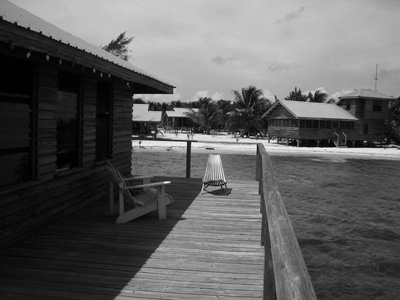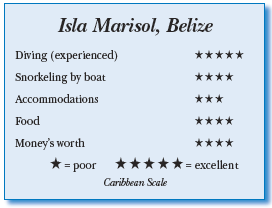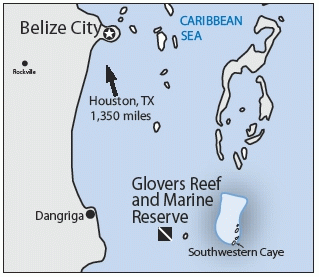Isla de Marisol, BelizeContents of this Issue: Dive Boats Hassle Utila’s Whale Sharks Getting Hooked. . . and Unhooked Editorial Office: Ben Davison Publisher and Editor Undercurrent 3020 Bridgeway, Suite 102 Sausalito, CA 94965 among the best, if it weren’t for... from the September, 2005 issue of Undercurrent
Dear Fellow Divers, Two summers running, I've been to a 12-acre atoll in Belize that is arguably not for everyone. No airconditioning anywhere. No-see-ums that will eat you alive when the wind is flat. The cabañas have electric fans, powered by generators quietly humming day and night. Bathrooms are small and clean, with fresh towels most days but no chair or table for reading or working on cameras. The cabañas have nice porches with chairs and hammocks, but sitting on them is an invitation for the no-see-ums. The mesh on the window screens is just large enough for a no-see-um to squeeze through, so I sprayed myself with DEET before bedtime. It's pitch black at night (that's the Southern Cross, out there) because there is no outdoor lighting. Most downtime I spent outside the bar at the end of a long dock looking at the long saltwater flats, watching the fish under the dock and reading a book. But I love to dive and this is my kind of place. You see, some of the best fishscapes in the entire Caribbean are here. If you come a few months earlier or later, breezes usually keep the bugs at bay. And the ambience is about as lost-in-the-tropics as one can get: a newly built, well-maintained island resort, referred to as a fishing/diving camp, on a sugar-fine sand beach -- indeed a magical outpost.
I spent two weeks last July and two more this June, logging 73 dives there, drifting gently along, often just the divemaster and me. The reef is healthy, though this part of the Belizean reef is almost entirely shades of beige and when backlit by the afternoon sun can look like spun gold. Lavender fans, purple sponges and gorgonians, yellow tube sponges and orange elephant ear sponges provide colorful touches. The critters are "wild" with no behavioral conditioning. Some combination of large groupers, sharks, rays and turtles showed up for every dive. Oceanic triggers were nesting. I saw many pairs of scrawled and whitespotted filefish, butterfly fish and angelfish; scorpion fish, green and moray eels, juvenile spotted trumpet fish; and ever-flowing blue rivers of creole fish, snappers, blue runners. One site had thousands of small silver fish, like a bait ball, that jacks enjoyed attacking. Looking through my Caribbean reef fish books, I've seen most everything here, except the biggest sharks. Isla Marisol is on Southwest Caye of Glovers Reef, which has been designated as a UN World Heritage Site and a Belizean National Conservation Zone, a reason that great fish populations survive. It's 28 miles from the mainland. Belizean Eddie Usher and his family have owned the island for 60 years, and not many years ago they built this "camp" for divers and fishermen. He can handle 22 guests, but while my spouse and I were there, we had the island to ourselves many days. Meals, and they are good, are served in the main building/dining hall, at long tables. Fans keep the air moving, and the screens mostly keep the no-seeums at bay. Breakfast was big: eggs, toast or pancakes or tortillas, avocado, cheese, often bacon or sausage and oranges, mango, watermelon and papaya juice from Eddie's own fruit farm on the mainland. (Fruit is available all day, as are cookies.) Lunch might be: conch ceviche with fresh tortilla chips, spaghetti and meatballs, chicken salad, tostadas, fish tacos, often a dessert. These meals are buffet style when guests number ten or more. But dinner was always served: a variety of fresh fish, lobster, shrimp, and once or twice a week, ribs, pork chops or chicken, with rice, pasta or potatoes; vegetables from Eddie's farm, cabbage salads (never fluffy greens); and cake, pies or ice cream. When not eating, sleeping or diving, I hung out at the bar, the property's family room. It has large windows on the three ocean sides and a ceiling fan. While ice-cold beer is the big seller, the semi-circular bar is well stocked. The staff takes turns being bartender. The bar space has several built-in small game tables with chess, checkers and scrabble. There are also a rack with books and magazines and low chairs scattered about inside and out. This year's divemaster, Chad, is perhaps the best 'valet divemaster' I have had in my 800+ dives (everywhere from Thailand's Andaman Sea to the Eastern Fields of PNG, from the Caymans to Islas Cocos). The large Buddha tattoo on his arm was my first clue that he is one relaxed fellow. He prefers to manage all your gear, setting it up and breaking it down, cleaning and storing it. That way he knows everything is OK and divers need only worry about diving. Besides aluminum 80s, they have two 50 and two 60 cu. ft. tanks (no Nitrox) and excellent rental gear, including computers. Dives are typically 9 a.m., 2 p.m. and 4 p.m. (night dives upon request). I asked for a 6:30 a.m. dawn dive, then 10 a.m. and 2 p.m., so that's what we did. Marisol has two boats, with cushioned seats down the sides and sun covers. There is no dive platform so I entered the water with a backroll, and my drift dive began. Captain, Fernando, followed our bubbles at discreet pace with the boat, and when I surfaced, he was right there. I handed up my gear, then climbed aboard a ladder hung over the side. On the rare occasion of a surface current, Fernando dropped a line to grab. The dive dock, by the way, is perhaps the buggiest place, being surrounded by mangroves and grass and protected from the wind. I put on my Lycra skin in my cabaña before going to the dive dock. But the bar is a wonderful place, usually bug free and cooler than anywhere else. The resort side of Southwest Caye is very shallow, facing into the protected
reef system. Even the snorkelers need a boat to get to snorkeling water,
a 10-15 minute trip. There are hundreds of potential unexplored sites. One day six high-pressure stockbrokers arrived. After 11 days of calm fishfocused, "be one with the reef" diving with no more than three other divers, a half-dozen adrenaline-filled divers were not much fun. They were so distracting, rocketing ahead, scaring off anything that might come by. The group's videographer tailgated me so close that his exhalations were startlingly loud in my ears. When I found a scorpion fish to tickle, there he was. Ditto for the bat fish. When I found an octopus half out of its lair, still finishing its meal of helmet conch, his camera was soon bonking up against the poor creature's home. Argh. The next day when they were scheduled to go see the whale sharks at
Gladdens Spit, (they did see the whale sharks) Chad and I went out earlier then
usual and left them eating breakfast and wondering why the boat left so early.
"Where did I want to go?" asked Chad. Canyons, my favorite dive site beckoned,
and the vis was good. The peace and quiet was wonderful. I renamed the
area Batfish Meadows in my logbook, because I saw the fish on each of my six
dives there: red, purple, green, even red-lipped batfish. I saw a pair of 3-
foot remoras lying between two coral heads, one upside down, the other across it
diagonally, looking exhausted, as though they had just mated moments before. Snorkelers do well here. The channel between Marisol and the Manta Resort is protected, warm and 10 feet deep at most. Yellow seahorses live under the dive dock, mautis shrimp in the mangroves and schools of snapper under the dock and the boats. Helmet conch march along the bottom. Southern stingrays drifted in the channel. One protected area off Long Caye, on the incoming tide, has a resident school of 1,000 bonefish that allow anglers to wade among them. I was happy to float among the bones, letting them surround me like a silver curtain, the sun reflecting off their scales like holograms, with little rainbows dancing around their silhouettes. So Isla Marisol, a throwback in time, is not for everyone -- unless, of course, you are a serious diver looking to leave civilization behind while you search for some of the best diving left in the Caribbean. April through June is whale shark season in these parts, when the critters extend from here to Utila and Isla Marisol devotes some weeks just to whale shark trips. The winds keep the bugs at bay but make for harder boat rides and lowered visibility. When the winds die, the no-see-ums can leave serious bites unless you're welllathered in DEET. But, if you're adventurous and prepared, this can be one inviting place. -- J.P.
|

I want to get all the stories! Tell me how I can become an Undercurrent Online Member and get online access to all the articles of Undercurrent as well as thousands of first hand reports on dive operations world-wide
| Home | Online Members Area | My Account |
Login
|
Join
|
| Travel Index |
Dive Resort & Liveaboard Reviews
|
Featured Reports
|
Recent
Issues
|
Back Issues
|
|
Dive Gear
Index
|
Health/Safety Index
|
Environment & Misc.
Index
|
Seasonal Planner
|
Blogs
|
Free Articles
|
Book Picks
|
News
|
|
Special Offers
|
RSS
|
FAQ
|
About Us
|
Contact Us
|
Links
|
3020 Bridgeway, Ste 102, Sausalito, Ca 94965
All rights reserved.


 The
first dive for new arrivals is Southwest Caye Wall, a sloping reef with consistently
good diving. Chad, a superb fish finder, will hold your hand or let you go, with the only restrictions being the
air in your tank and the readings on your
computer. Cruising the edge of the wall,
on many dives I found eagle rays and had
huge schools of fish swirling around me.
The farther one travels toward Long Caye,
the deeper the reef shelf gets. A dive at
Northeast Caye started at 50 feet and just
got deeper. There were huge crevasses in
the reefs and scattered beige growth. Not
many fish. By the time my tank was empty,
the reef was 120 feet below.
The
first dive for new arrivals is Southwest Caye Wall, a sloping reef with consistently
good diving. Chad, a superb fish finder, will hold your hand or let you go, with the only restrictions being the
air in your tank and the readings on your
computer. Cruising the edge of the wall,
on many dives I found eagle rays and had
huge schools of fish swirling around me.
The farther one travels toward Long Caye,
the deeper the reef shelf gets. A dive at
Northeast Caye started at 50 feet and just
got deeper. There were huge crevasses in
the reefs and scattered beige growth. Not
many fish. By the time my tank was empty,
the reef was 120 feet below. A
stingray, a spotted ray, hawksbill turtles, varieties of grouper and large running
schools of blue creole rounded out this beautiful dawn dive. (Last year
we had sharks, rays or turtles on
every dive. This year, a shark
study group was at the Nature
Conservancy the week before, counting
and tagging sharks. As a
result, I saw only one small nurse
shark.)
A
stingray, a spotted ray, hawksbill turtles, varieties of grouper and large running
schools of blue creole rounded out this beautiful dawn dive. (Last year
we had sharks, rays or turtles on
every dive. This year, a shark
study group was at the Nature
Conservancy the week before, counting
and tagging sharks. As a
result, I saw only one small nurse
shark.)  Diver's Compass: Most people can arrange flights from Miami or
Houston to Belize City and on to Dangriga without a layover. If
not, Belize City has a couple decent hotels, or go to Dangriga
Pelican Beach Resort, which is $92/night for two for a decent
room (but lousy snorkeling) . . . After bringing in guests in the
morning, Eddy picks you up at the hotel or the Dangigra airport
and departs Stann Creek by 3:00pm to ensure the two-plus-hour
boat ride ends in daylight . . .Guests can arrive and depart on
any Wednesday or Saturday. . . Low season rates run $1,550/person for the week,
high season $1,750, for everything, including diving; nondivers pay $650 less .
. . Eddie prefers cash or even personal checks due to the fees and percentage
points that he will charge you if you use a credit card . . . There is no outside
night lighting, so bring flashlights to find your way to your cabaña after
dinner; you can do it without flashlights but land crabs come out after dark
and could pinch bare toes. (The sand is white, clean and soft, and there are
no rocks). . . .Some people come just to kayak among the cayes, others to cast
flies for bone fish, or troll for barracuda, wahoo, king fish, even sailfish
or blue marlin. Guide Ashton Ritchie, with a lifetime of experience on these
waters, runs small open boats for snorkeling and fishing. The informative Web
site is
Diver's Compass: Most people can arrange flights from Miami or
Houston to Belize City and on to Dangriga without a layover. If
not, Belize City has a couple decent hotels, or go to Dangriga
Pelican Beach Resort, which is $92/night for two for a decent
room (but lousy snorkeling) . . . After bringing in guests in the
morning, Eddy picks you up at the hotel or the Dangigra airport
and departs Stann Creek by 3:00pm to ensure the two-plus-hour
boat ride ends in daylight . . .Guests can arrive and depart on
any Wednesday or Saturday. . . Low season rates run $1,550/person for the week,
high season $1,750, for everything, including diving; nondivers pay $650 less .
. . Eddie prefers cash or even personal checks due to the fees and percentage
points that he will charge you if you use a credit card . . . There is no outside
night lighting, so bring flashlights to find your way to your cabaña after
dinner; you can do it without flashlights but land crabs come out after dark
and could pinch bare toes. (The sand is white, clean and soft, and there are
no rocks). . . .Some people come just to kayak among the cayes, others to cast
flies for bone fish, or troll for barracuda, wahoo, king fish, even sailfish
or blue marlin. Guide Ashton Ritchie, with a lifetime of experience on these
waters, runs small open boats for snorkeling and fishing. The informative Web
site is 